-
Between describing and shaping/manipulating reality: Data versus Photography
by Mark van der Net 7 jaren,3 maanden geleden
For a talk at BredaPhoto festival I was seduced to compare data with photography. When walking through all exhibition rooms filled with photos - ranging from reportage, lunar photography to conceptual and highly artistic staged photography - I could not help wonder why nobody became enraged at the work because it didn't show an accurate picture of reality, while that happens to data – from analysis to artistic - all the time.
It's probably because photography is around for some 150 years and people got used to the liquidity of the medium between describing and shaping or – more negative: manipulating - reality. Photography started in the hands of science people like Daguerre and Muybridge using it to capture reality in new ways. From the cityscapes of Paris to the movement of horses and people.
It did not take long for people to extend the as-is realism of photography to better suit certain objectives; from a bit of retouched flattery in portraiture, the professional glamour shots that dominate advertising to the flood of machine-learning enhanced selfies on social media.
During the twentieth and early twenty-first century photography democratized both truth finding as reality distortion and the viewing public became sensitive navigators of the creative field between.
The relatively young medium of data cannot count on such sensitivity. It finds itself often torn apart as either (acted upon) as complete truth or utter nonsense. The medium and its practitioners suffer from impostor syndrome.
The binary responses to data actually stems from the same mistake: To see data as claiming reality – and accept of reject it as such – instead of seeing it as a means to describe and shape reality. Of course the strength with which data-believers and exploiters claim reality invites strong rejection but it withholds data as a medium the creative field in between and the public the possibility in getting sensitized to its logic and liquidity.

I think we should talk about the wide and strange spectrum of data – from reconstructing reality and simulating it, estranging from- as identifying with it, to the reflection on what it has to tell us and using it to shape reality in a new image.
In the presentation I showed some examples illustrating that reality is not lost in a world which data certainly shapes and manipulates in numerous ways. From the disruption of Airbnb to the reconstruction of the airplane crash of MH17 by Bellingcat, the deep-fake porn videos and the self-design when entering into a data-feedback loop with yourself.
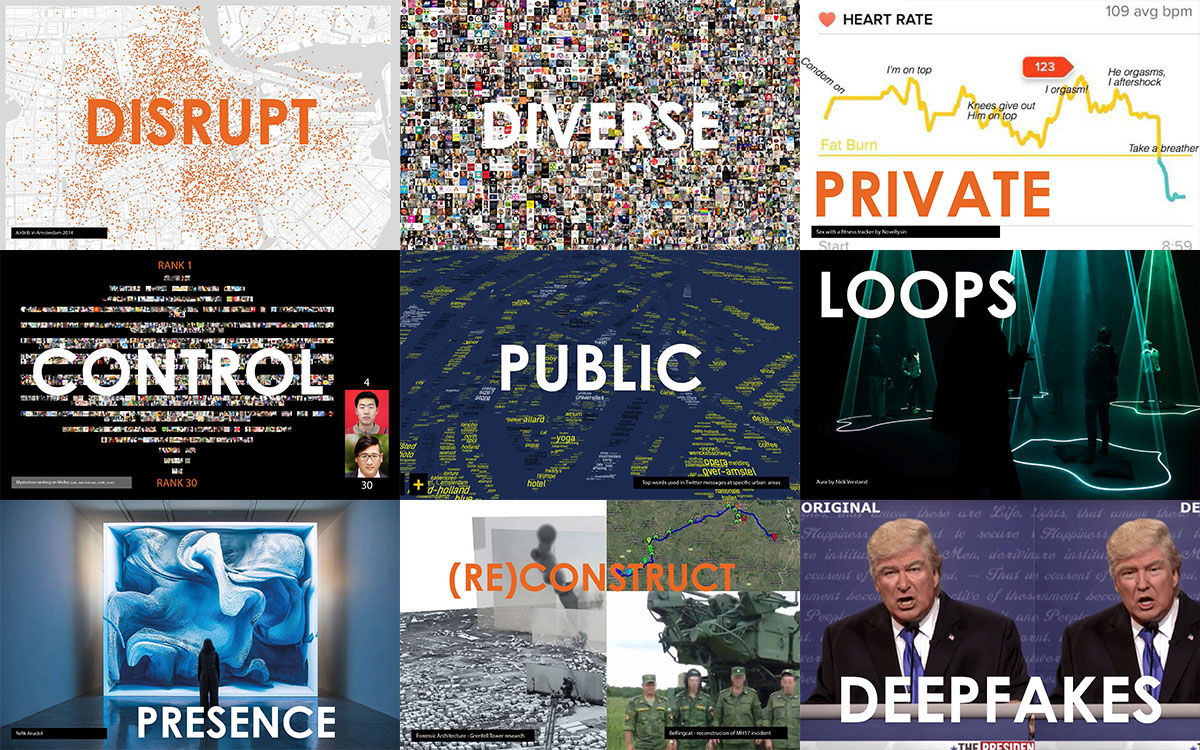
-
Challenges from Smart Cities to traditional urban planning
by Mark van der Net 7 jaren,8 maanden geleden
Based on some presentations I gave on Googles plan for Toronto (see below) I created this diagram to figure out how the traditional urbanism might be challenged by the more technology and webbased orientated methods and businesses:

-
Five reasons to pay attention to Google's Plan for Toronto
by Mark van der Net 7 jaren,9 maanden geleden
At the end of 2017 Google – with its daughter company Sidewalk Labs - entered the business of urbanism by winning a large scale competition in Toronto with a master plan that promises “the first urban district entirely invented and constructed from the Internet up”.
Many critics hastened to condemn such a development from the outset- seemingly purely based on the nature and track record of Google as a highly competent software company and its monopolistic tendencies.
Headlines like “Dreamcity by Google can become a nightmare” ( NRC 30/10/2017 ) or “City of the Future? Humans, Not Technology, Are the Challenge in Toronto” ( New York Times 30/12/17) focused on the evident pitfalls like privacy, democratic governance and ownership, transparency and inclusiveness.
But to me this criticism displays a certain simplistic reactive-reasoning that is somewhat illustrative of the inability of many fields of knowledge (journalism, culture, politics to name a few) to really catch up with the ways of technological thinking and doing championed by Google. That's a pity, because by venturing into urbanism Google opens itself up for more refined scrutiny and perhaps dialog.
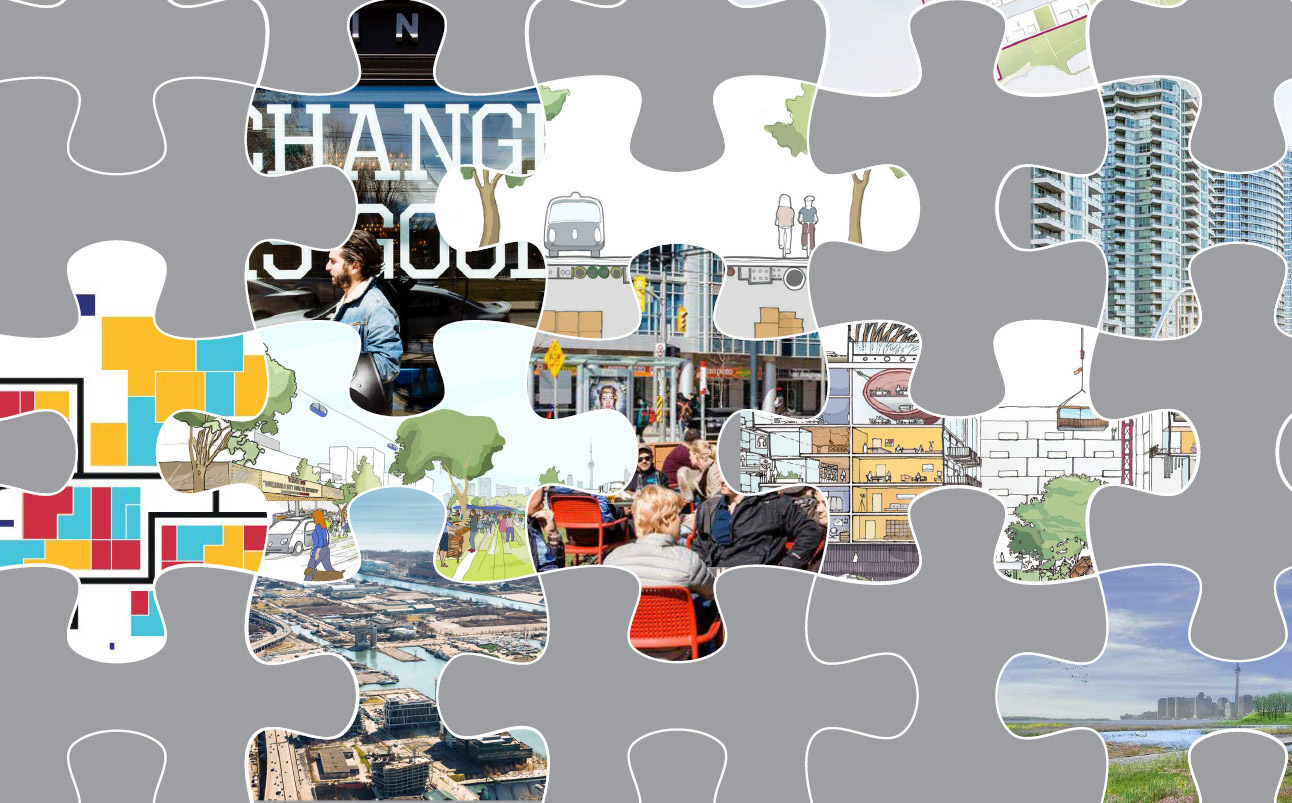
Indeed, reading up on the rich plan by Sidewalk Labs, one notices that the proposal is already very much in dialog with its possible weaknesses and criticisms. This vision is not so much the result of a blind and irresponsible adoration of technological progress we are accustomed to from Silicon Valley.
It actually is a rather bold attempt to create a cohesive integral vision – probably the first one of all so called Smart City developments - of urban living both physical and virtual in the 21st century. One that is – in my opinion – mostly missing in the traditional, ad hoc field of real estate development.
Here are some original ideas of the Toronto proposal I think haven't got enough attention:
Design based on KPI's between top-down and bottom-up
We have seen fragmented small Smart City projects in Europe and some in the U.S. ( 'add-ons', problem-centered) and large top-down ones in Asia and the Middle-East (political lock-in, techno centered ). Both had their own problems; The first lacked a strong and integral vision and business case to scale or survive the messy political processes. The second have troubles to connect the high-level political goals with people that need to live (in) them.
The plan of Sidewalk Labs offers a middle road with its clever combination of design based on key performance indicators (KPI), governance-processes ( like regulations ), platform-based organization and people-centered services and products.From artwork to system of change
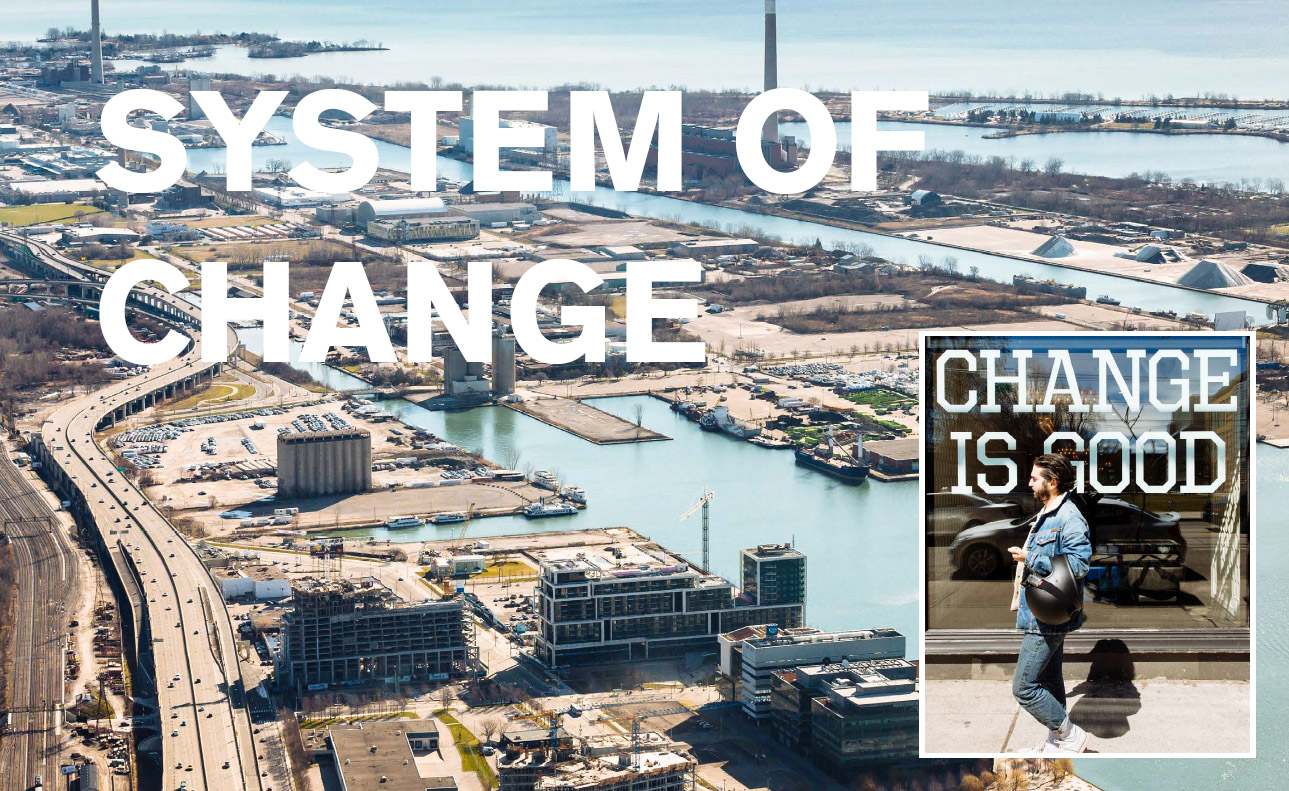
Urban developments are often seen as the pinnacle of a certain time period, organization and expression of politics and power. After construction changes to cities are gradual, if at all. Sidewalk Labs envisions a very adoptive city, a platform for algorithms and programs. Regulations become (KPI controlled) algorithms, modular buildings can be easily changed and moved and data gathered can be used to improve the systems and generate new services. This results in a completely different model for urban development and value creation.
Urban value creation: innovative community value

Once urban projects are build, its value increases with its ability to attract more people, activities and most importantly; capital. Illustrative; It is quite an accepted way to start developing an urban area by giving artists and entrepreneurs low rents and slowly replacing them with people who can afford higher living costs. Financial value creation is the goal, not social value creation.
With some imagination one can read a new form of urban value creation in the Toronto plan: namely the value that is created within a community by its social dynamics, creativity and of course willingness to try out new technologies. Will this innovation value result in products that can scale out to other cities and justify the higher investment costs? Also how durable and inclusive is this urban laboratory business model?People-centered design
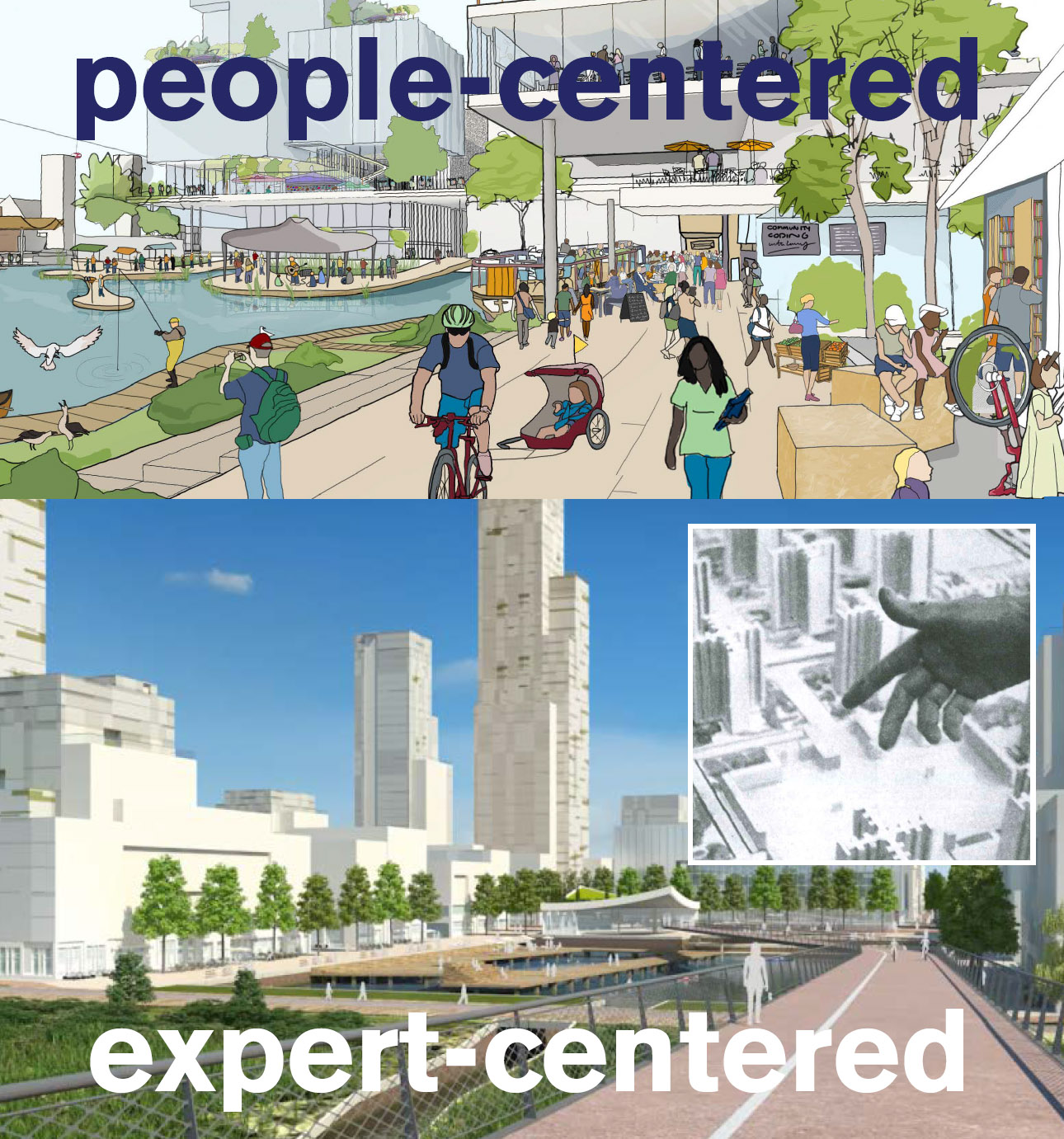
Google's user-centered approach to products translates directly into its vision for urbanism. The sympathetic illustrations consciously show a lot of people and all the services and products they are offered by a urban environment. One can easily look through the eyes of Google and see the possibilities for products, user experiences and the needed infrastructure within this messy, suboptimal urban field. Depending on your inclinations; that can be either positive, frightening or challenging. But after all said and done; this focus on either the person, user or citizen and their specific relations and desires towards the city is a good thing that may not yet get the attention of architects of traditional urban plans.
Google's promises beyond GoogleThe Toronto plan by Sidewalk Labs is a highly ambitious and innovative approach to urbanism, in which change itself is the only constant. The city becomes a system of change; with both adoption, community-lead innovation and technology push in seemingly equal measure. Of course the plan is clearly in line with the ideas and actions of Google as we know it. But by anticipating criticism as part of the already pretty rounded proposal – for example promising affordable housing for all - Sidewalk Labs leaves the fast paced train-of-though of Silicon Valley and takes on more responsibilities; suggesting alternative mechanisms than just market-driven technological products. Is that a proposal for a Google social housing in the plan?
No one knows how the new urban district of Sidewalk Labs will look like – but it deserves to be closely watched – because it might not only reinvent urbanism but also Google itself.
-
Preview: Online tool die jou precies vertelt wat je vergunningsvrij mag bouwen
by Mark van der Net 8 jaren,3 maanden geleden
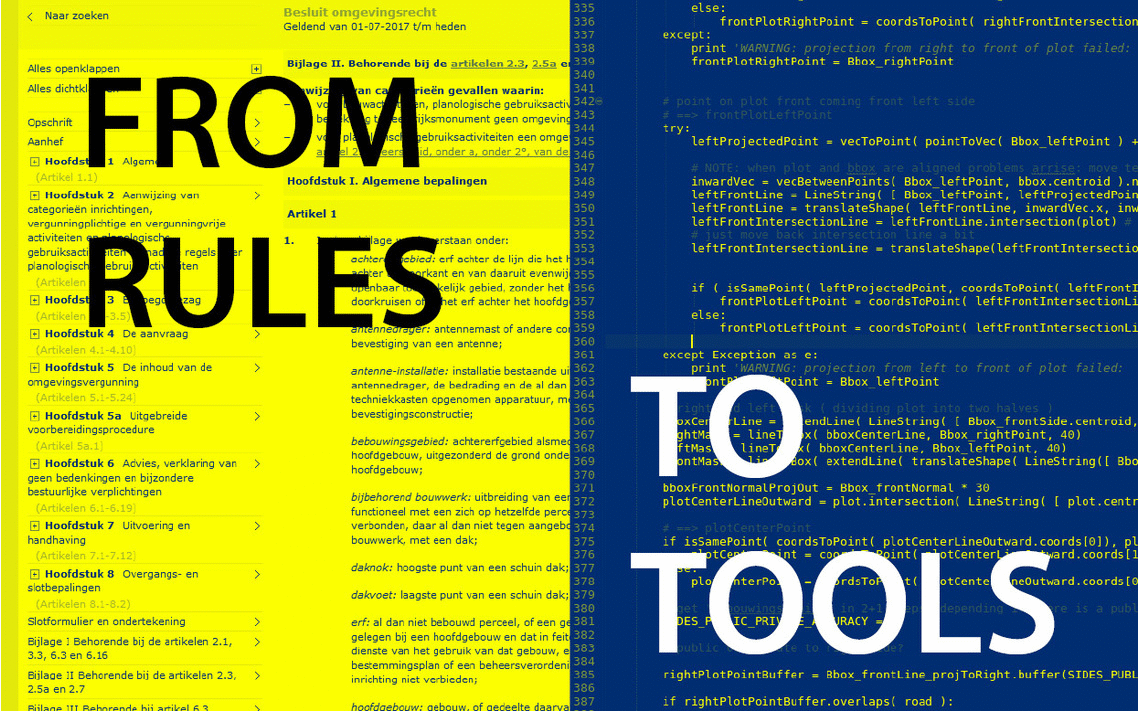
-
Mentioning Cities
by admin 8 jaren,5 maanden geleden
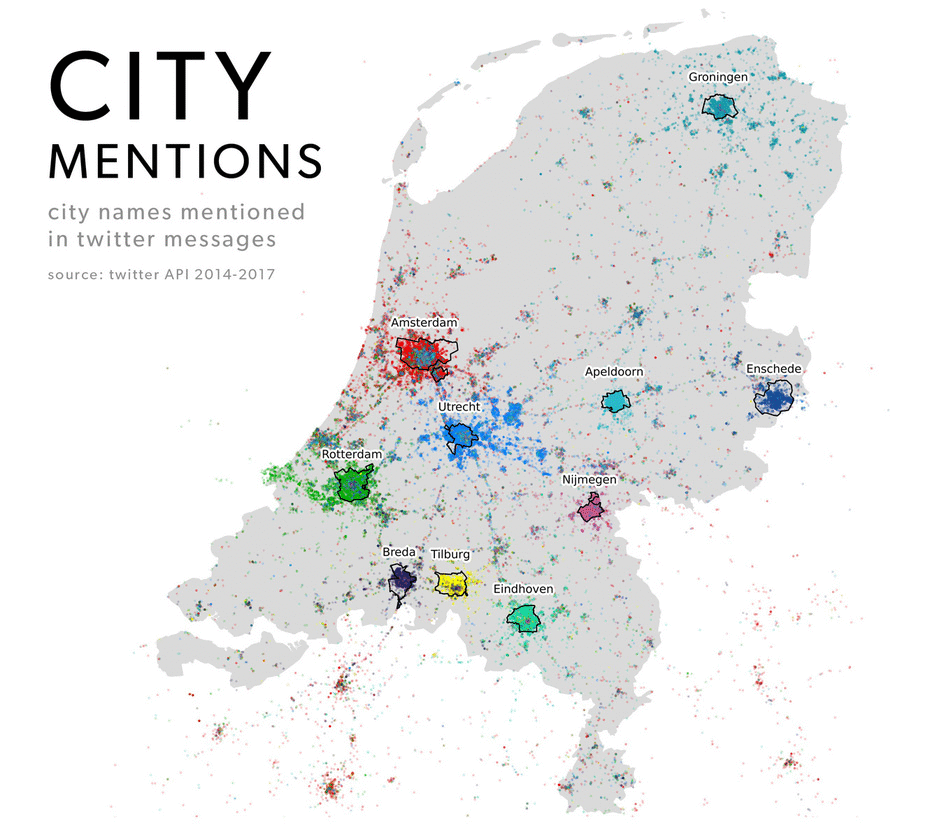
Based on our Twitter maps ( tweetcity.oscity.eu ) it was already obvious that the world of tweets is very much anchored to the local urban one. I wondered what cities names are mentioned, how much and from where. Does this say something about the importance of the city, its outreach and relations with other cities?
-
4 x big data: From the sublime to the scary
by admin 9 jaren geleden
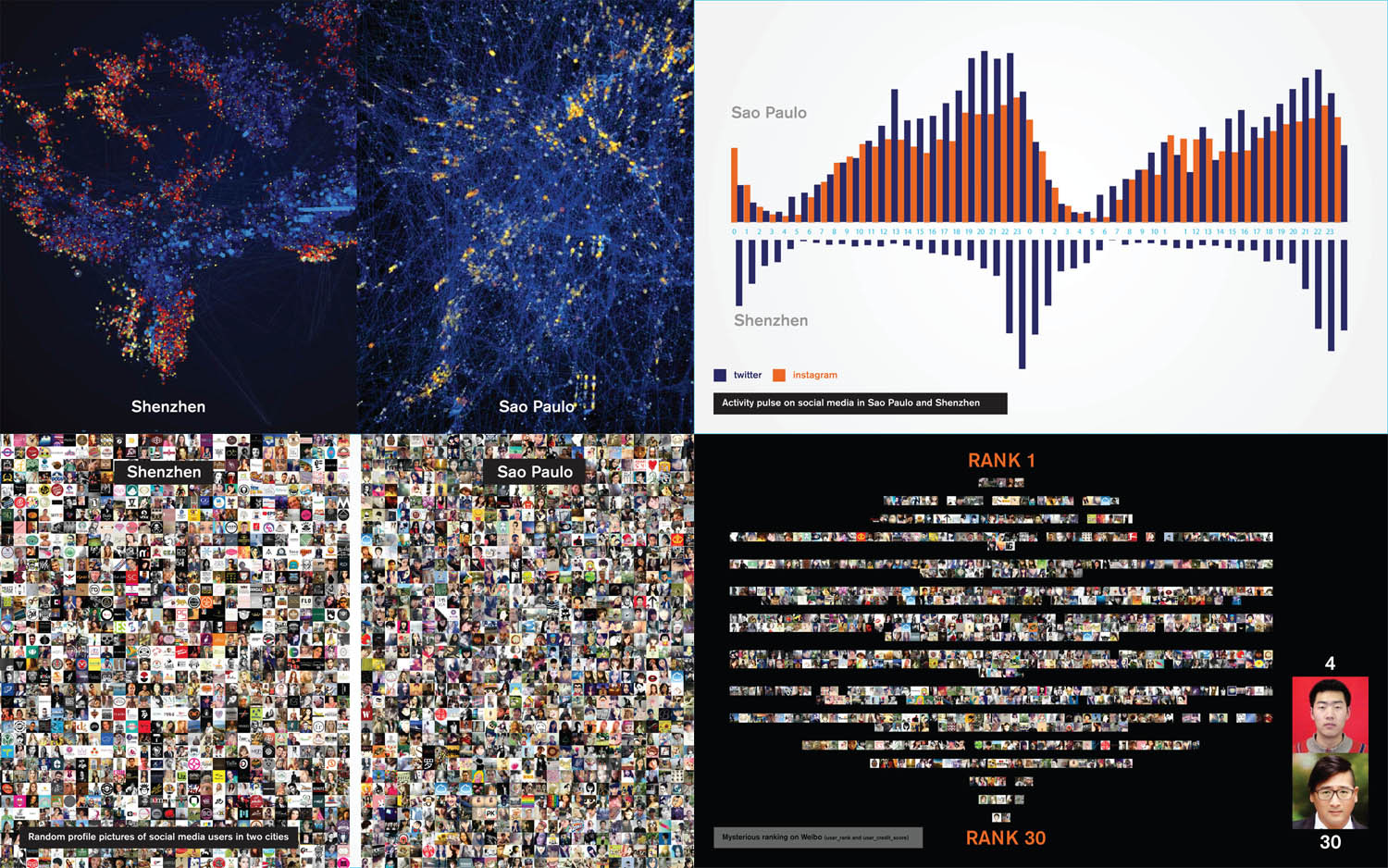
Our technology-driven society inattentively leaves large traces of data. Collecting and researching that big data sometimes feels not unlike being a beachcomber. The things that wash ashore are presumed trash by the people who are not looking for treasures.
That leaves the beachcomber to pick up the objects that escaped the depths of the ocean, were ratteled loose from their context, function and meaning by the surf and afterwards gleam on the sand for him to find, reconstruct and reinterpretate.
It's sometimes entirely unclear if some hidden truth came to the surface or the imagination of the beachcomber. Or both.
The above pictures show 4 representations of the same dataset. A couple of months of Social Media data from Sao Paulo and Shenzhen.
The first shows all messages geographically plotted and colored based on their time of creation. It shows the urban activities and interactions of both enormous cities. The second image shows these by time.
Even more fascinating is the realization that this data is not abstract, but in some way comes directly from people; showing something very personal. A sublime diversity and freedom comes to light.
Data enabled this seamingly unbridled energy to flow, but might equally be used to control it. Shown are the traces of what seems to be China's Social Credit sytem which are already integrated in the social medium Weibo in the form of credit scores and user ranks.
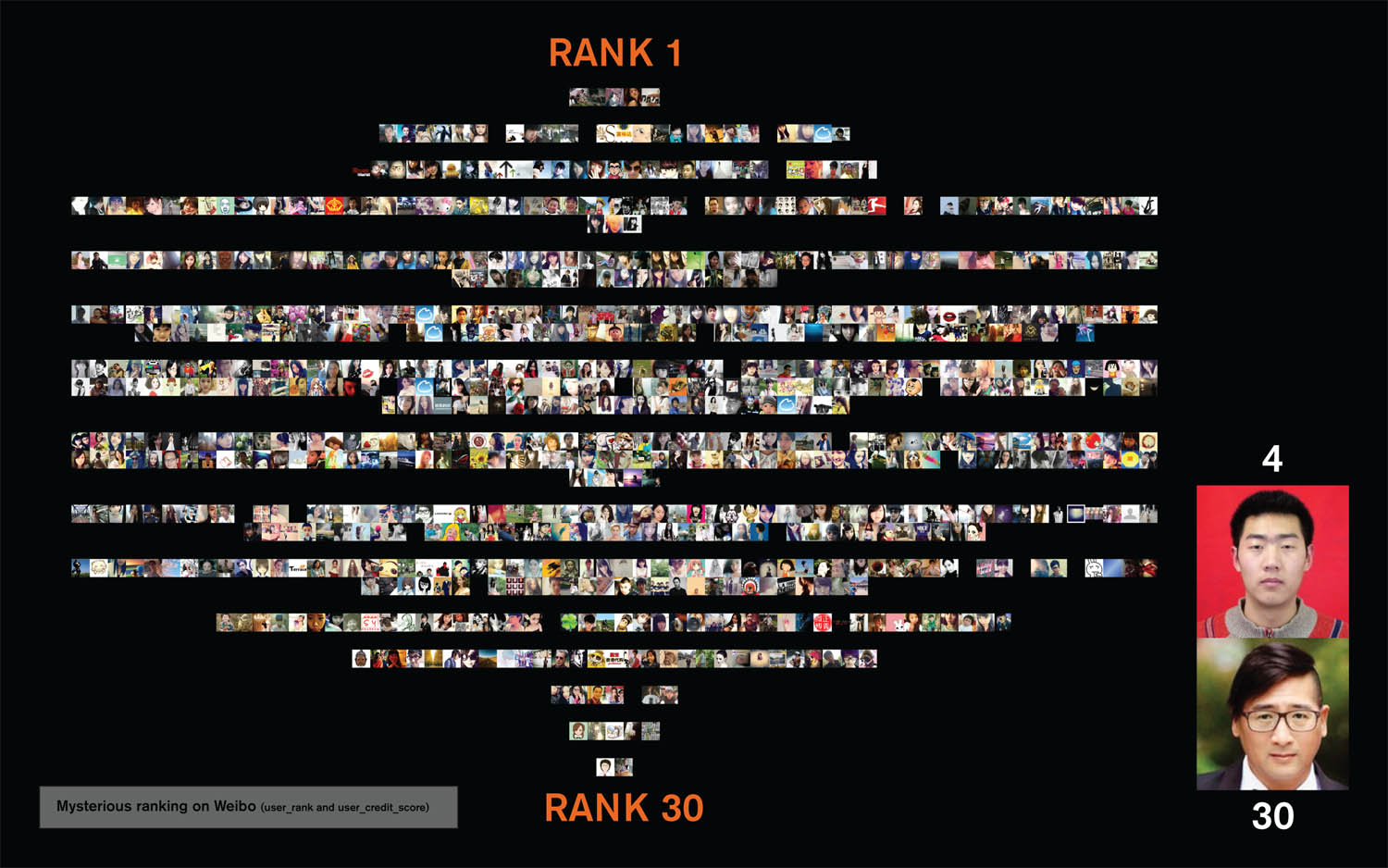
-
Tweet City App
by Mark van der Net 9 jaren,2 maanden geleden
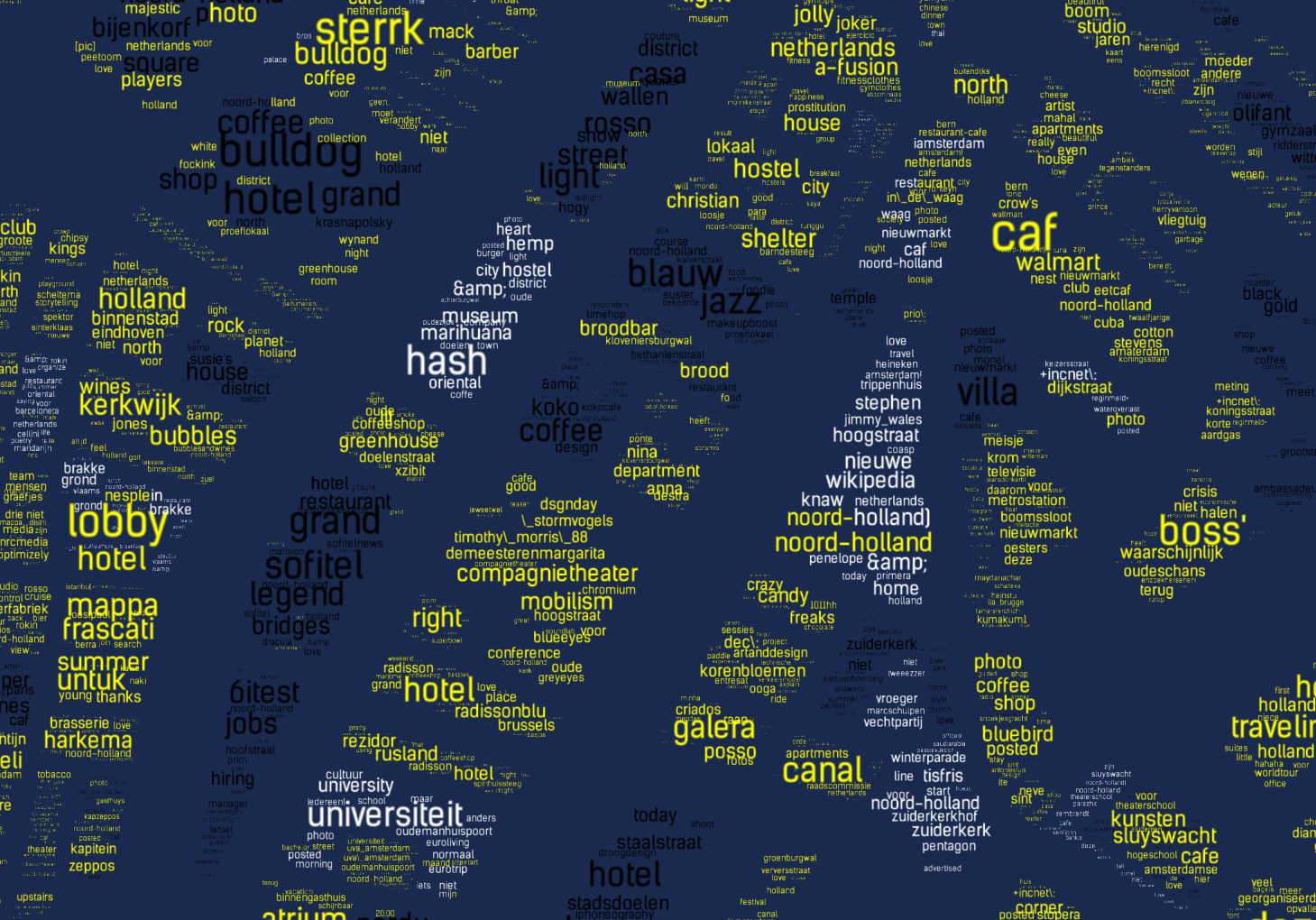
Have a look at tweetcity.oscity.eu; A new experimental web app that shows geographic wordclouds in different cities. It allows us to research the spatial dimensions of social media. Not only on a long timescale (it shows how geo Twitter messages describe local urban reality quit well) but also at special timescales (events for example). To be continued!
-
AIrbnb keeps growing
by Mark van der Net 9 jaren,5 maanden geleden
It's a holiday tradition; firing up the scraping script and seeing how big Airbnb has become since the last year. The results this year show a prolonged growth of homes (more than 14.000) on Airbnb in Amsterdam. It probably means that Airbnb has become a mainstream way to earn money (for a holiday) during the holidays for a lot of people in Amsterdam.

It probably matters a lot in which summer month you aggregate the listings. Last year I got the listings in june, which showed a relative small increase from the previous year in august. It looks like august is the top month, because this year has almost twice as many homes offered than in the same month in 2014. The supply probably follows the demand.
This year Airbnb also restructured its data, with some nice details, notable the profiles of hosts. More analysis will probably follow.
-
Mirror of Society: the public won and lost..
by Mark van der Net 9 jaren,6 maanden geleden
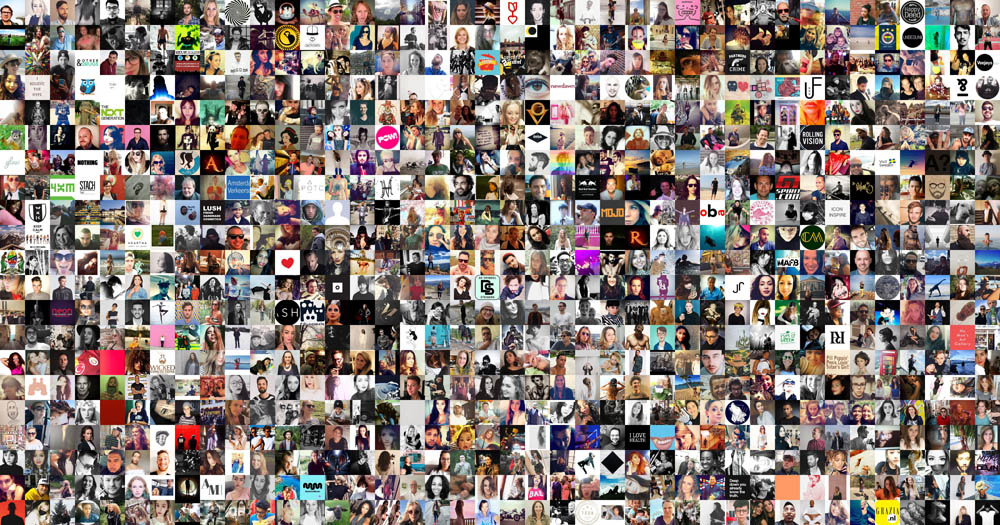
One of my favorite social media - based on its data ofcourse! - is Instagram. It features an rather diverse community. Of course it is not the entire society, but judging on the profile pictures - it is a very lively, creative and self conscious hybrid subgroup.
The openness of these (mostly young) persons is striking - with a surplus of talent. Dialogue seems easy. Can this energy be more than lifestyle and posing? With other words: Is Instagram/Facebook - if that's even so - underestimating these people by seeing them primarly as targets for marketing campagns and profiling?
One thing is clear: Instagram and Facebook are not seeing these platforms as a new public sphere: Instagram closed their official public API last june, ending or at least strongly limiting the general access to its data and its possibilities.
If Instagram is not creating it, we might never see a service that freely matches creative talent, informs us of trendy urban areas in real time and generally all services that take this striking diversity as a starting point for innovation.
And above all: witholding society a mirror to look in..
-
Instagram City
by admin 9 jaren,6 maanden geleden
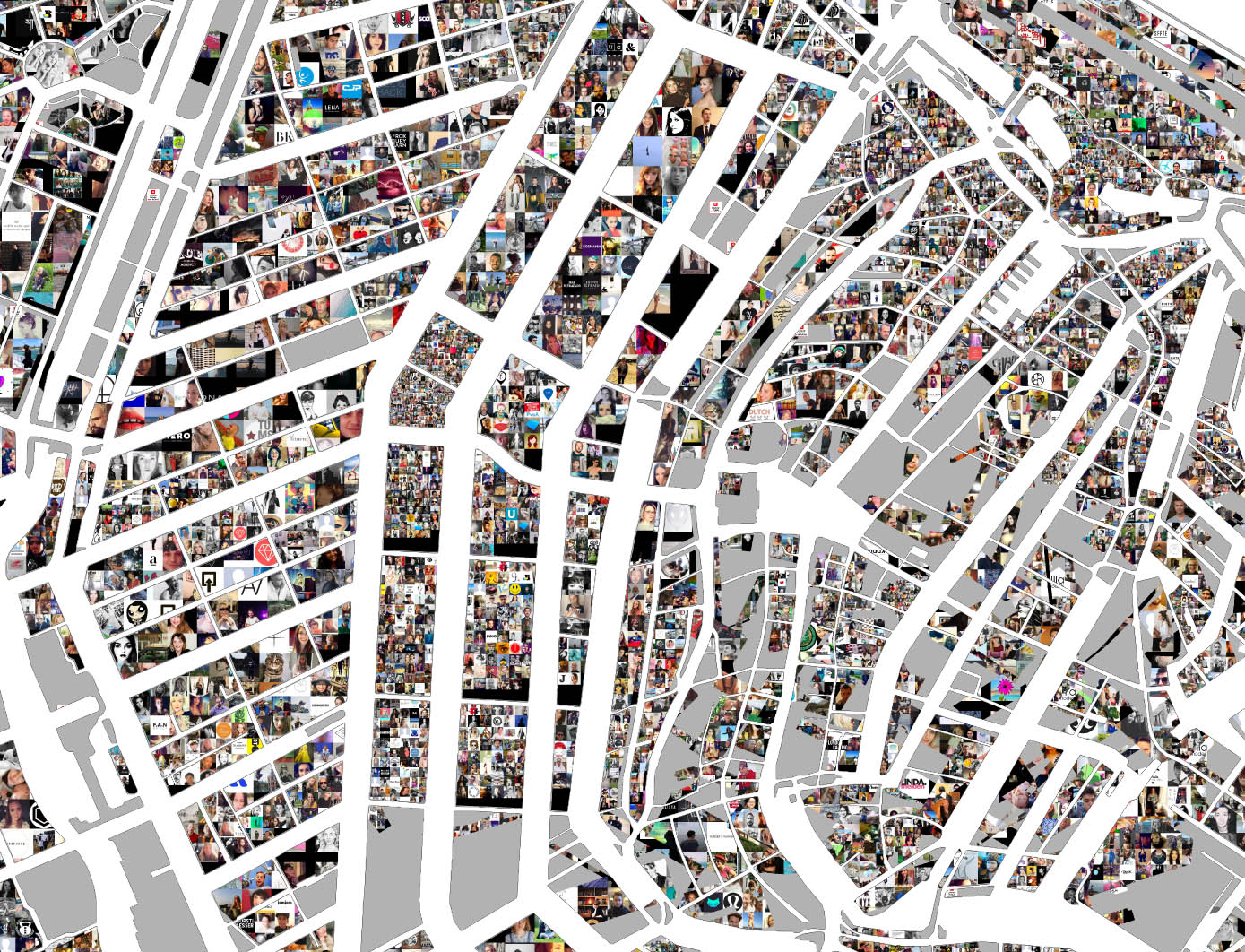
After the city described by Twitter, this one was long in the making. It shows all the profile pictures of people who created photos within that certain area. You can see what areas are more crowded than others. I haven't really checked if there are clear differences between areas and types of people. I do suspect that the audience on Instagram is quite narrow and centered on young urban hipsters! More to come..
-
New version of Babel
by Mark van der Net 9 jaren,7 maanden geleden
The new version of Babel is optimized to show more content, shows spatial clusters, can plot GIS data as base map.
Working towards more cities (Sao Paulo, Seoul, Amsterdam). Also inventing ways to show the logic of cities in real time.
-
Outlines for an Urban (Artificial) Intelligence
by Mark van der Net 9 jaren,7 maanden geleden

Everybody's talking about artificial intelligence nowadays. But what about the collective artificial intelligence humans have been creating for millennia: Namely cities ? Can we instead of creating isolated smart machines explore this collective intelligence of cities and enhance it with the latest technologies like big data and machine learning?
First these new technologies enable us to close the gap between the urban planning tradition (top down, centralization of power, teleological) and daily urban culture (bottom up, distributed and p2p networks and without one goal or design). Never before could we have insights into urban life like we have now with data from social media, sensor networks and all the objects we daily use within the Internet of Things.
These data streams can be captured in real time. Allowing us to follow the daily urban systems while they are working by and for people. And because of this empirical base we can develop models for understanding these urban processes. In my opinion this - apart by some pioneering research groups - happens not often enough yet.
The necessary understanding of cities starts from the diversity of its inhabitants and the daily urban systems of organizing them together with infrastructure and resources. It also needs to end with people: serving individuals and groups with the aim of a emergent higher collective intelligence and thus public good. This we call people-centered design which is the main subject of the Design+Desires program with Droog Design.
In a lot of ways we can use web culture as an important inspiration. A variety of technologies and online platforms are allowing people to try new organizations, markets and communities parallel to the old ones. There are invisible cities inside the old ones being tested and eventually built.
My intuition is that we can create a whole new breeding ground from the combination between daily urban life and systems, the smart of cities and people centered design. This can serve more than just urban planning but can be a source for social, economical, political and technological innovation. After all technology needs to be developed in tune with society to avoid push backs like we are already seeing today which are equally bad for technology as society.
The increase of technological possibilities within a highly virtualized society raises urgent and complex questions and forces societies to make hard choices. This is illustrated by the application of big data in China to create a stringent social ranking hierarchy of society. But equally to the enormous amount of intelligence that is poured into the rather dumb task of profiling people for marketing and advertising purposes by the big American tech companies.
I would like to argue that we need to bring technology together with daily needs and desires of modern life, the existing collective intelligence within society and knowledge from the forefront of pioneering economies and cultures.
Cities seem good places to start.
These thoughts were the product of the wonderful experiences at Path Festival in Sao Paulo and Rio. Thanks to the organization, KLM, the Dutch Consulat, Dutch Culture, The Waag Society and my impressive travel compagnons.
More data will follow!
-
Launch Design + Desires website
by admin 9 jaren,8 maanden geleden

In collaboration with Droog Design we launched the Design+Desires platform: the place for people-centered design and research. It is home of the Design+Desires method, which includes social media mapping, dialogue tools, research and design projects. A center piece is Social City; a virtual city that is slowly growing based on the needs and desires people from all over the world given to us through the unique gamified quiz.
-
Nieuwe planningsmethoden
by Mark van der Net 10 jaren,2 maanden geleden

Naar aanleiding van de inspirerende conferentie getiteld Nieuwe Planningsmethoden in Pakhuis de Zwijger van 8 oktober, hierbij een uitgeschreven versie van onze presentatie rondom de mogelijkheden van data voor de ruimtelijke planning. Hier te downloaden
Steden, van groot tot klein zijn fascinerend. Soms vermoed ik dat ik weet waarom; Ze beschikken over een even complexe als creatieve lus. Zoals Churchill opmerkte; Eerst vormen we onze steden en daarna vormen zij ons.
Het eerste hebben we tot de crisis volop gedaan. Dat bouwen ging heel erg over individuele prominente gebouwen. Maar nu schuilt het antwoord op veel vragen rondom draagvlak,veerkracht, sociale rechtvaardigheid, transformatie in het tweede. Dit bouwen gaat veel meer over de stad als geheel en van binnenuit. Het gaat om het ontdekken van wie we zijn en wat we willen worden. Om het daarna te bouwen.
Dat trekt me zo aan in technologie. Het geeft ons de middelen om het gat te dichten tussen onze vooropgezette noties van de stad enerzijds en haar echte dagelijkse processen in al hun complexiteit en schoonheid anderzijds.
Veel van die stedelijke energie wordt namelijk gefaciliteerd en opgevangen door software en het internet en wordt zo dus data. En data heeft eigenschappen die we volgens mij goed kunnen gebruiken.
Het geeft grootschalig en meetkundig inzicht en betrekt zaken op elkaar. In feiten en meningen; Harde en zachte data...rondom ontwikkelingen op lange termijn. Je kunt het ook erg goedkoop beschikbaar stellen en hergebruiken. Het geeft heel gedetailleerd inzicht (en bevraagt daarmee ons concept van privacy) . Het komt vaak binnen in 'real time' en schept een direct handelskader. En als je dan iets slims hebt werken, kun je het ook nog eens heel makkelijk ergens anders herhalen. Het maakt ideeën enorm schaalbaar, in overeenstemming met de stedelijke groei in Afrika en Azië.
Het enige probleem is echter: Data is een middel. Het is niet altijd even duidelijk welke proces of doel het dient. Maar ten aanzien van de stad wist Frank Lloyd Wright het eigenlijk al: “After all is said and done, he –the citizen- is really the city. The city is going where he goes.”
Een burger-gecentreerde planning dus, die uitgaat van de behoeften en verlangens van mensen, op individueel- als groepsniveau, op korte en lange termijn. Luisteren naar de stad dus, laten begaan, faciliteren en bijsturen in het publieke belang.
-
Tweet City
by Mark van der Net 10 jaren,4 maanden geleden
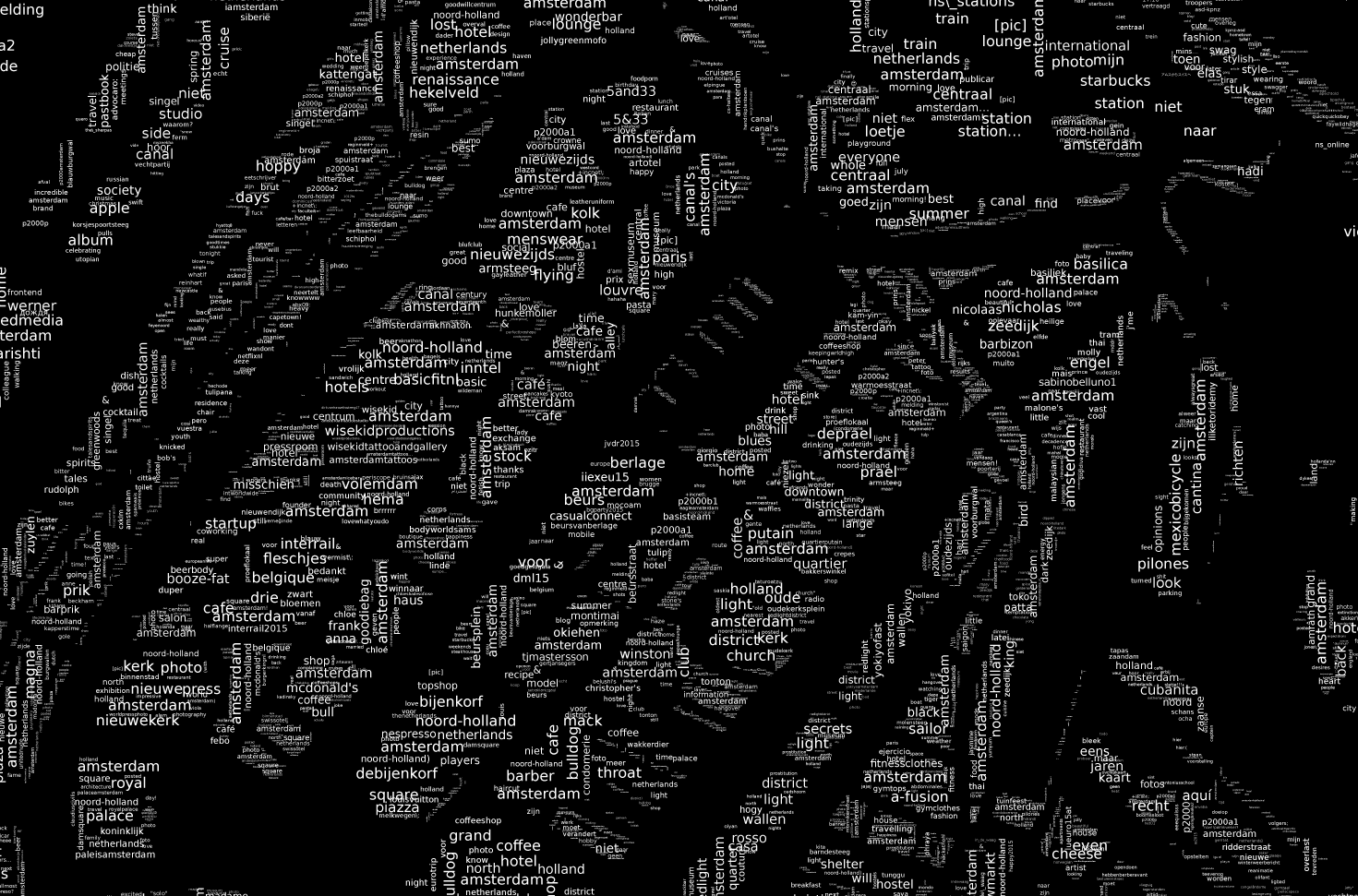
Another experiment: plotting the most mentioned words on Twitter per building block in Amsterdam. Big data makes cool posters! Have a look at a large version
For the fans of Eindhoven: here is a poster
-
Evolution of elder care buildings in NL
by Mark van der Net 10 jaren,5 maanden geleden
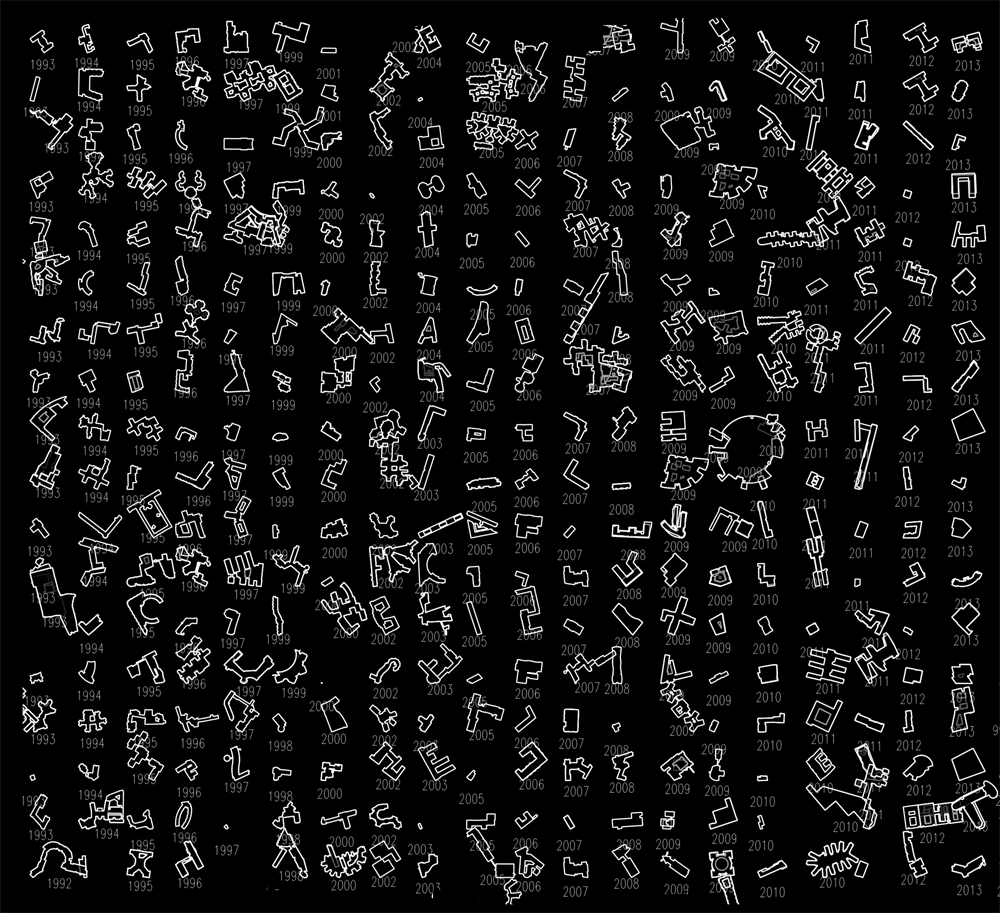
As part of our ongoing research into the way elder care is organized we created this overview of all elder care buildings by construction year. With data-technology we gain a very broad picture of all health care real estate and its surroundings. The main goal is to use this data to create insights that help communities, public officials, healthcare professionals and investors make the most of these buildings and organize care in other ways when they are threated with closure.
-
Crowdsource Mining for Shenzhen Biennale
by Mark van der Net 10 jaren,5 maanden geleden
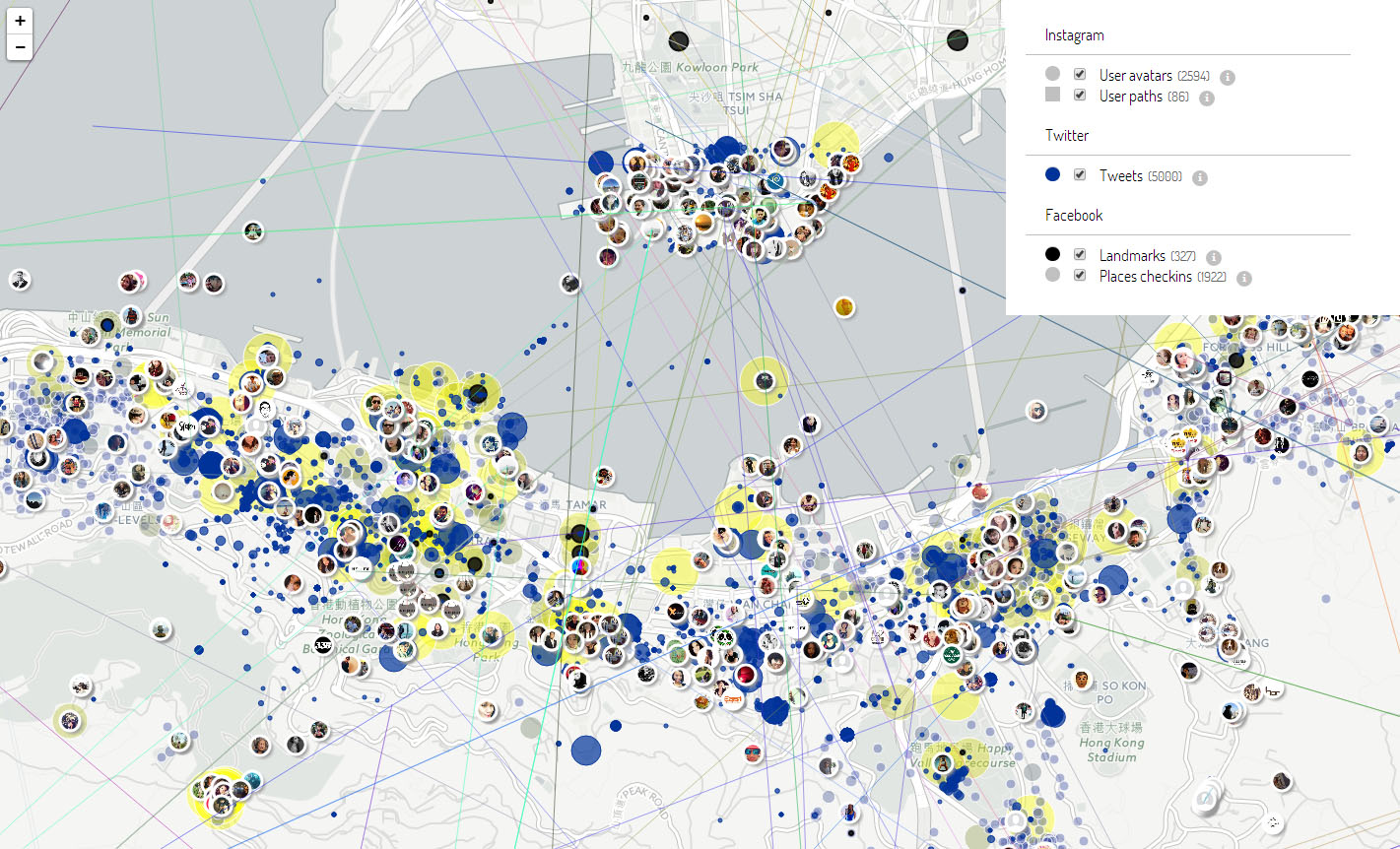
Started mining large amounts of big data from social netwerks like Facebook, Instagram, Twitter and Weibo. For the Urbanism Architecture Bicity Biennale (UABB) - and as part of programme Design+Desires we are looking for the dreams and desires of Hong Kong and Shenzhen citizens.
-
AirBnb trends
by Mark van der Net 10 jaren,6 maanden geleden
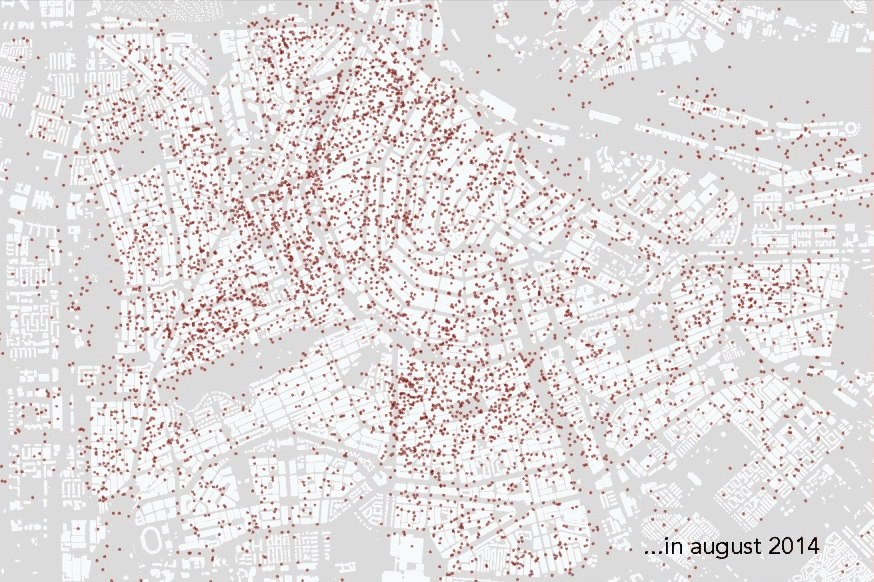
Coming up: a study of spatial trends of AirBnb
-
The Smart of Cities and big data
by Mark van der Net 10 jaren,7 maanden geleden
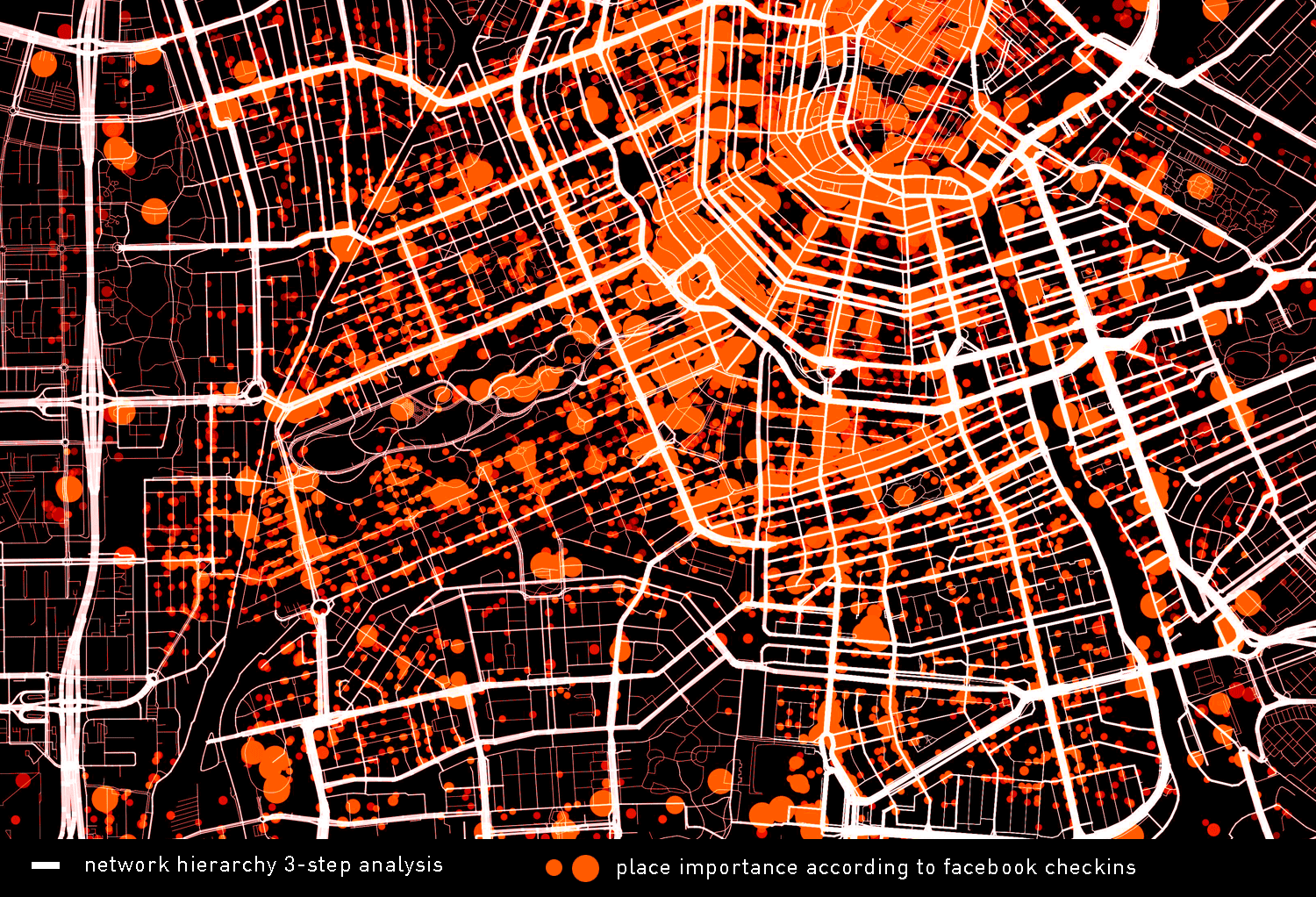
How do you know that urban concepts, models and plans are effective in governing and developing cities? Until recently urban professionals actually could not and did not. The field of urbanism has been plagued with a lot of good intentions going wrong rather quickly. Think about the Dutch New Towns like Almere or the large-scale modernist housing blocks in the periphery of so many European cities. And we expect more problems to arise.
It seems that these plans and the urban profession as a whole still lack a certain scientific rigor and a good grip on the fundamental processes that take place in cities and shape them. Like Churchill wrote: “We shape our buildings, and afterwards our buildings shape us”.
With ample seduction, rhetoric and creative power the former certainly happened. Still nothing much is known about the latter. In that sense architects and urban designers still shape cities without actually understanding its existential nature and elementary processes.
That's why I find big data so appealing. Today as never before, it is possible to bridge the gap between our conceptual comprehension of cities and the real thing in all its beauty and chaos. In other words: Understand it as a complex system with so many different parts working together to give rise to qualities that we want stimulate or steer slightly in the right direction.
Big data will give us access to the century old knowledge built into the city itself and that of its (past and present) inhabitants. Thus generating possibilities of strengthening our society based on the intelligence of open urban culture.
The city is already quite smart; It's our understanding that lags behind. We have to follow before we can lead.
-
Doe-open festival
by Mark van der Net 10 jaren,7 maanden geleden
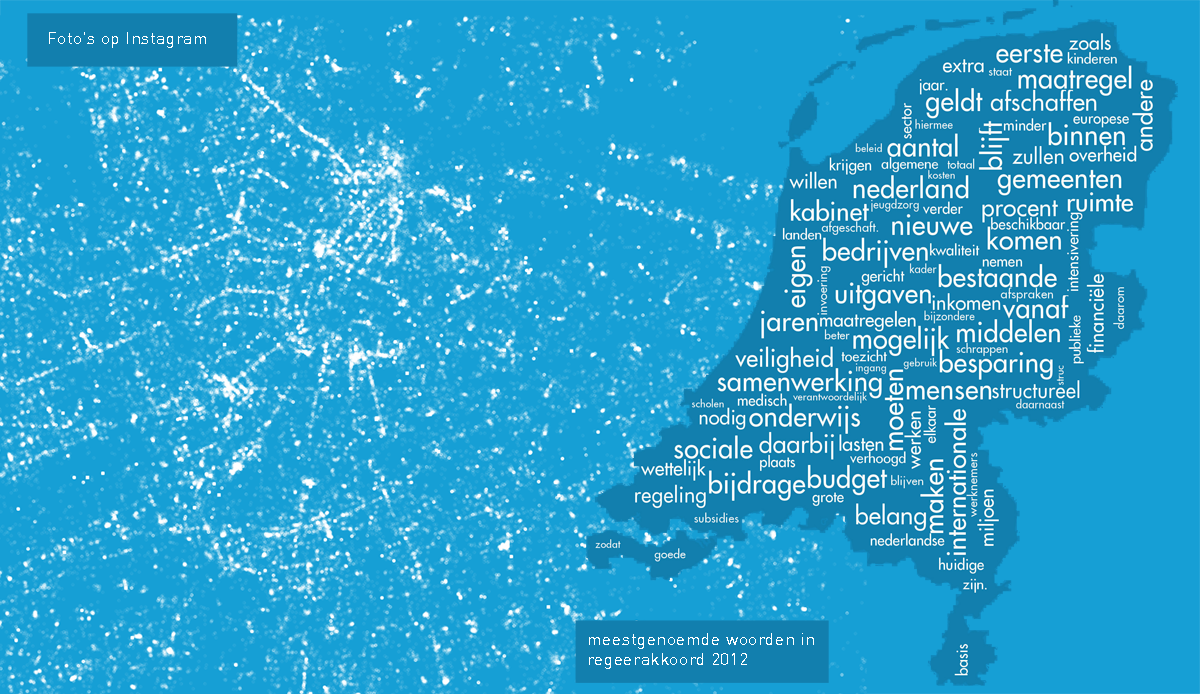
Op 18 mei is het Doe-Open festival in Pakhuis de Zwijger met o.a. Minister Plasterk en Job Cohen.
OSCity geeft een korte bijdrage over wat Nederland heeft aan data. Zie de website van Pakhuis de Zwijger voor het hele programma.
Hieronder een transcript. Download de presentatie hier:
Nederland is ons gegeven...Dat klinkt natuurlijk tamelijk vaag en idealistisch – maar in toenoemende mate is het heel concreet.....namelijk in data. Data betekent letterlijk het gegevene.
Zo is bijvoorbeeld heel Nederland door overheidspartijen gedetailleerd ingescand en vrijgegeven als open data. Ook de dynamische processen die zich dagelijks in Nederland afspelen en het land uiteindelijk vormgeven komen beschikbaar in data
Dat roept natuurlijk de vraag op: Wat hebben wij er aan? Is dit slechts een video-game? En wie zitten eigenlijk aan het stuur?Hoe abstract ook, technologie en data vormen geen andere wereld, ze zijn onderdeel van de onze. Een spiegel om in te kijken. Een unieke inkijk in het leven van jezelf en dat van anderen.
Dat lijkt ook hard nodig want de maatschappij is volop in beweging. Terwijl velen gekluisterd zitten aan hun smartphone komen er wel degelijk serieuze problemen op ons af.Wat als we die problemen nou eens kunnen aanpakken en vooral onze gadgets daarbij niet hoeven weg te leggen. Al die data is namelijk een enorme bron van kennis en een basis voor veel veranderkracht.
Zo is het nog nooit zo makkelijk geweest om goedkoop een auto te huren, samen groene projecten op te zetten of je zorgaanbieder te waarderen. En zo zijn er nog duizenden voorbeelden.Een simpele website waar mensen hun woonruimte kunnen aanbieden aan touristen is in enkele jaren uitgegroeid tot een stedelijke kracht. Data creëert een nieuwe realiteit. Zonder veel inzicht en proactieve rol van maatschappelijke partijen overigens.
Dat is jammer want de rijkdom ligt letterlijk op straat. Veel sociale platforms lijken wellicht fragmenten van een toekomstige maatschappij, maar worden gemaakt door commerciële bedrijven. Die worden rijk door te doen alsof de straat van hen is.Toch is het nooit zo makkelijk en goedkoop geweest om sociaal kapitaal inzichtelijk te maken en te gebruiken. Die data, dat zijn wij.
Als je bedenkt dat techbedrijven deze data met name gebruiken voor advertenties, valt er nog veel meer mee te doen. Maar dan moet iedereen kunnen meekijken, meedoen en een aandeel kunnen nemen in zijn eigen kapitaal. Open dus.
Een beetje zoals mensen van nature met hun stad doen. Hier ontstaat dan ook een hele interessante versmelting tussen het fysieke en virtuele die weleens heel veel impact kan hebben. Open data is niet genoeg. Er is een open stedelijke cultuur nodig.Complexe maatschappelijke vraagstukken rondom ouderenzorg of demografische krimp hebben waarschijnlijk een dergelijke innovatieve cultuur nodig als oplossing.
Veel Amerikaanse techguru's verkondigen graag een totaal nieuwe wereld en verklaren het oude irrelevant. We hebben als Europeanen een enorme kans om dit beter te doen. Het gaat erom het nieuwe van culturele relevantie te voorzien.Daarvoor moeten we wel beseffen dat technologie een spiegel is waarin we moeten blijven kijken om zo onze individuele belangen en die van Nederland te blijven heruitvinden. Wegkijken is naïef en controproductief.
Mijn voorstel is te beginnen met wat ons is gegeven. De rest heeft nog een open einde en vereist nog veel werk. -
Smart Eldercare
by Mark van der Net 10 jaren,9 maanden geleden
Started a new project with One Architecture and The Mobile City that will look into the future of (smart) cities and how they can offer care for the elderly.

-
City lifestyles in Twitter data
by Mark van der Net 10 jaren,9 maanden geleden
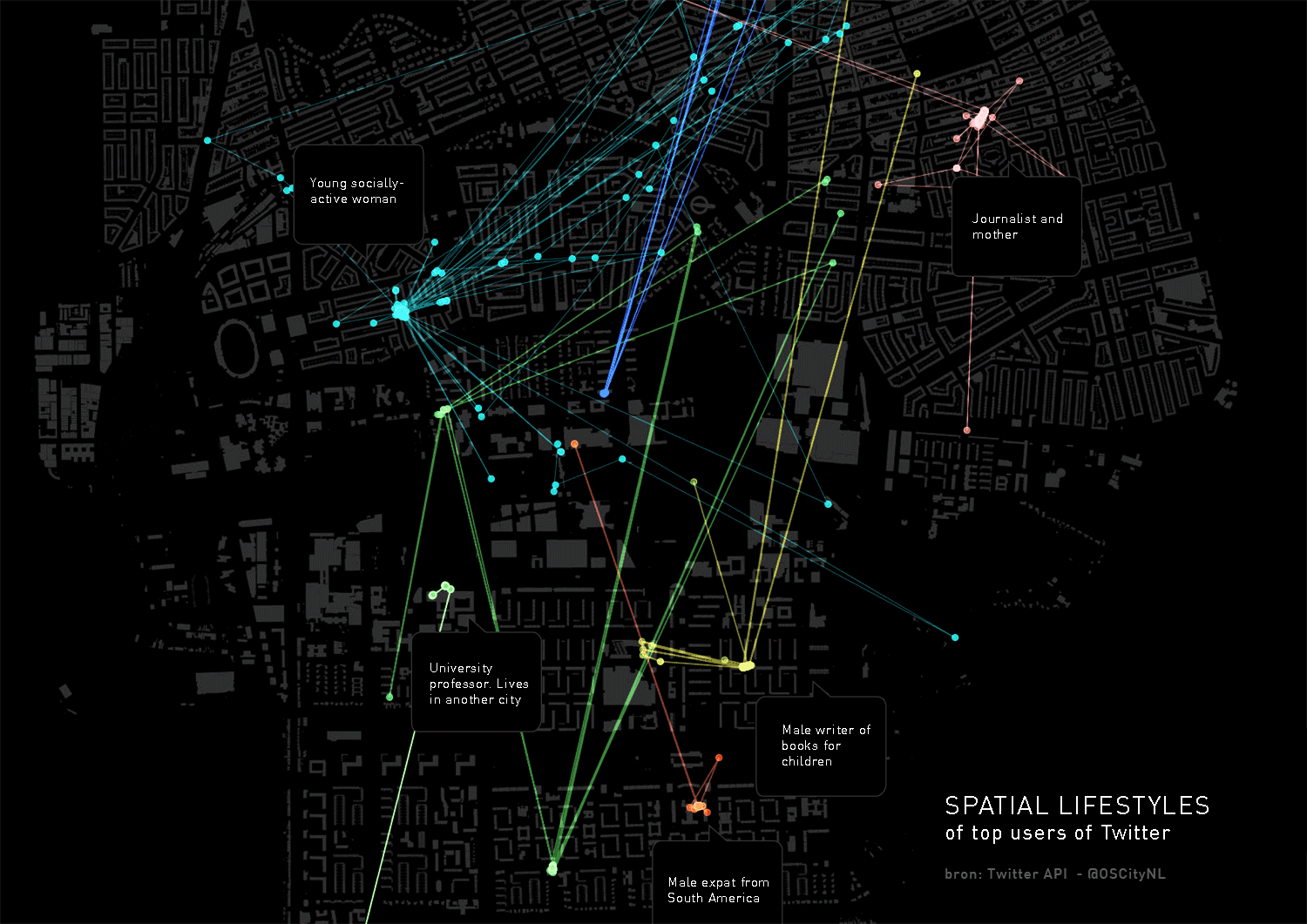
Will there be a time when people give away their data - consciously - in return for a richer urban life? And will urbanists, architects and designers work accordingly?
-
Crowd Source City
by Mark van der Net 10 jaren,10 maanden geleden
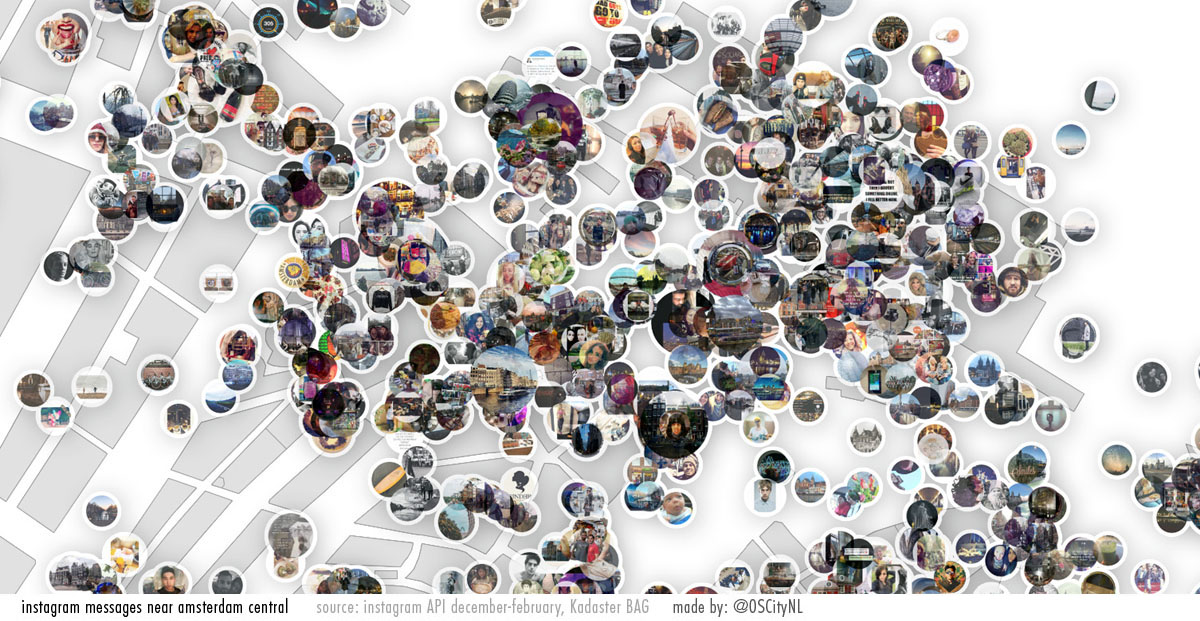
Social Media are platforms for countless interactions, opinions, affections and ideas. By using them in a certain way people show what they find important and desire.
All these entries aggregated create a large crowd source in which the wisdom of the crowds is stored. Of course many bigdata companies already try to mine it. Mostly for marketing ends (Gnip, Factual), but also for better routing (Waze) or journalism (dataMinr) and many others.
I am interested in the information of urban life that flows through cities and that builds them on the long term. By using social media people share their knowledge about where to go for a quiet walk in the park or finding cool people to hang out with in the hot nightspots. The city also has the knowledge infrastructure to turn ideas into reality; what like-minded people are near you and are able to help you out.
What if this self-learning characteristic of the city is freely available for the people who created it in the first time? This is a idea that I will explore in the coming projects and tools and I called 'Crowd Source City' .
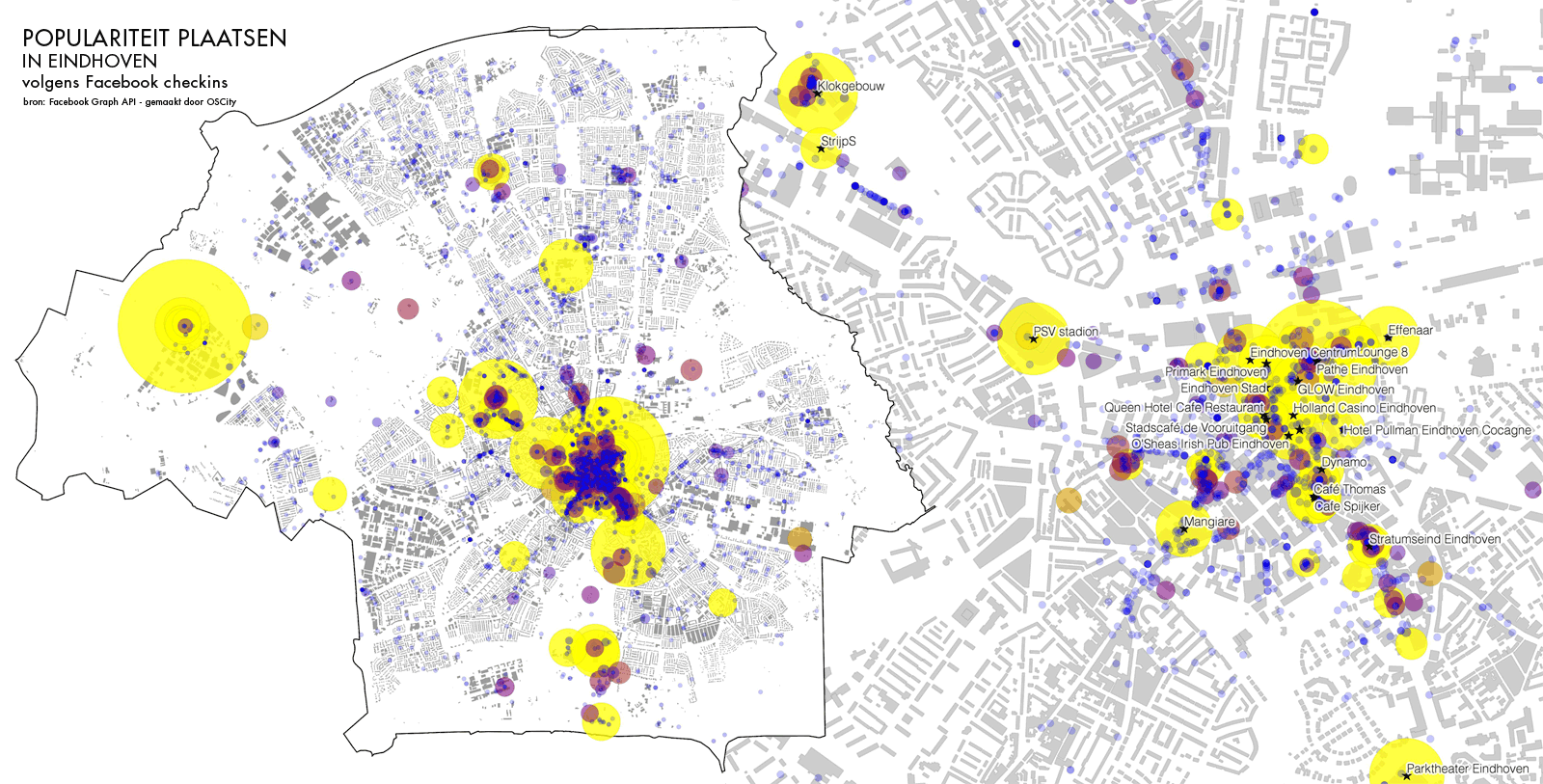
-
What does Geoffrey West know about Dutch Cities without visiting?
by Mark van der Net 11 jaren geleden
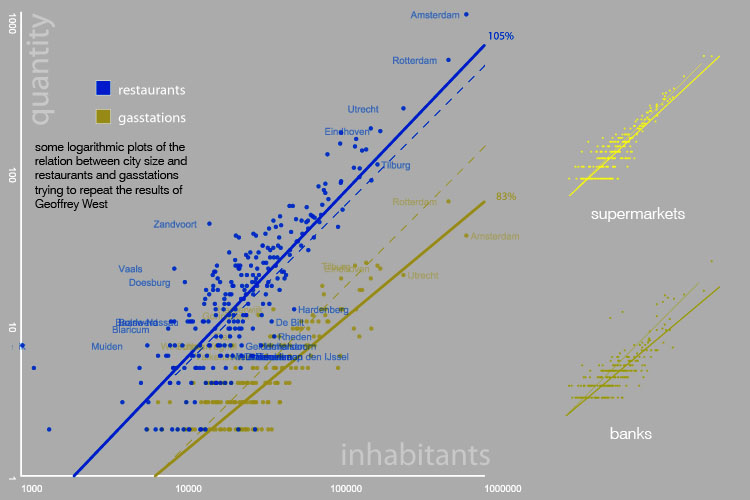
Geoffrey West, a British theoretical physicist once claimed at a conference that before he started to work on the subject of cities there was no scientific urban theory. Of course the city also deserves a softer qualitative treatment but after so many centuries of urbanism the results of Wests quantitative approach are surprisingly fresh. Maybe urban lovers and haters alike indeed forgot to consider the simple numerical facts?
Wests thesis - put forward in highly accessible lectures like that at TEDTalks and articles in Nature - states that cities follow simple mathematical 'laws'. It turns out that a lot of urban quantities ranging from infrastructure, income, patents, to number of crimes and gas stations are lineaer.
Meaning that if you have double the amount of inhabitants in a city - instead of getting twice as many gas stations for example - one finds 15% less than expected. So bigger cities are more effectively organized. Other properties like income, patents - but also crime - on the other hand show a relative increase of 15%.
So this so called 'super linear scaling' could be the bottom-line why so many people live in cities everywhere. Indeed this 'everywhere' is important. According to West all cities in the world follow these 'universal' rules, with only small variances due to specific differences. This is because cities are inherently (social) networks. Networks that make the potential of the city grow without apparent boundaries.
I put some Dutch data together to try to repeat Wests results; no doubt without his scientific rigour and mathematical ingenuity. Still I could find a lot of the same striking properties.Update 2015: The theories of West and Bettencourt captured the public imagination with presentations (like the TED talk) but only slowly found their way in the academic discourses and especially in the professional urban design field. For me it is still a bit unclear why this is so. Some responses criticized the methods like the rather elaborate philosophical presentation by Ludger Hovestadt that seems somewhat characteristic of complex entanglement between the scientific and artistic within the architectural and urban design profession. A more robust assessment came from Batty and his research group from the University College London which found that population size alone provides insufficient information to describe a state of a city. Also the research found most urban indicators (patents, income) in the UK scale linearly – and not super-linear.
-
Housing in the Netherlands versus Belgium
by Mark van der Net 11 jaren,3 maanden geleden
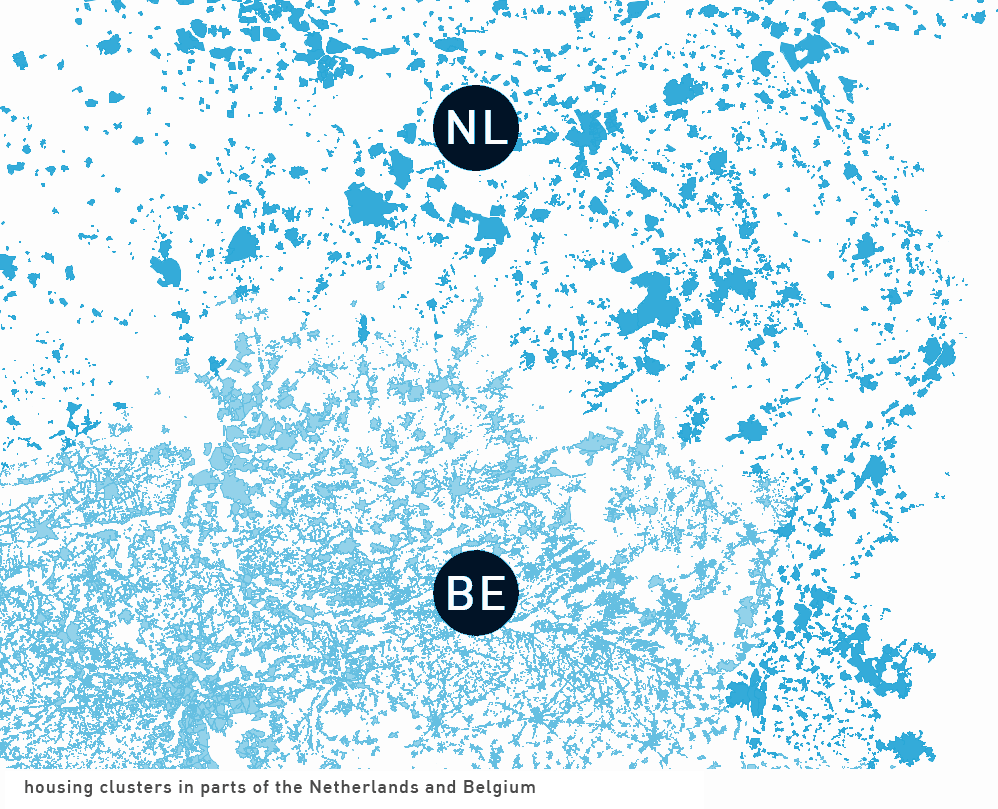
Everyone (in this part of Europe) knows: The Netherlands and Belgium are in many ways quite alike. But when it comes to spatial planning they are almost mirror images. Where the Netherlands grew from the existing urban cores (and some new), Belgium adopted a wildly distributed urban sprawl.
Both models have their merits and are mentioned in both countries in both positive and negative terms and in that way are still very much 'talking' to each other. This data visualization shows that quite clear.

